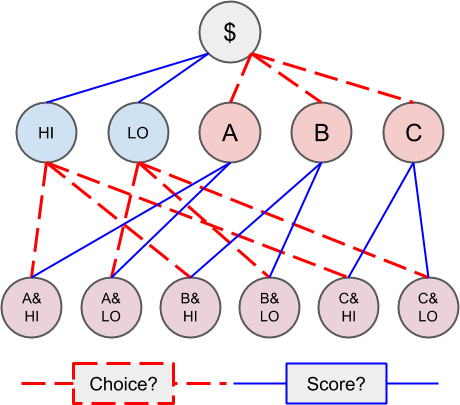Splitting Unions
Previously, we split collateral into positions (A) and (B|C). But we there are many more valid splits we can make with the conditions we have created.
Here is an example of some valid and invalid splits, either from collateral ($) or from other positions.

Looking at the below image of positions, you'll notice a second layer of positions, this tied very closely to the parent collection ID parameter. When we passed in 0x0 as the parent collectionId what we are telling the contract is we would like to start from the root collection or the collateral token directly.

A simple example, using our previous positions, would be to split (B|C) into (B) and (C). You can try this split with the current state of the conditional tokens contract on your development chain.
To do this, we will call splitPosition(), keeping the collateralToken the same using using the address of one of your ToyTokens.
We will also keep the parentCollectionId the same, 0x0. The parent collection ID can be roughly thought of as the next level up.
We'll keep the conditionId the same as well, because that is the condition that outcome collections containing only (B) and only (C).
Change that occurs here is in the partition. We want to figure out the index set values for only B and only C. With the process noted earlier, we can find those values. For example, the index set for the outcome collection containing only (B) is 2, and the index set for the outcome collection containing only (C) is (4).
Since this does not cover all of the outcome slots in the condition, the split will actually look for value in the position (B|C) instead of trying to get value from one level up, or in this case is from the collateral token.
Try calling splitPosition() to split a portion of your (B|C) position into (B) and (C).
Using the same method as earlier, you should be able to derive the positionId for these new positions and check your balance of positions (B|C), (B), and (C).
In the next sections, we'll cover combining outcome collections and splitting into deeper positions.
